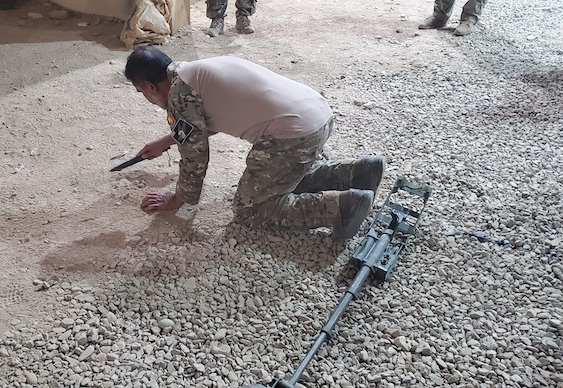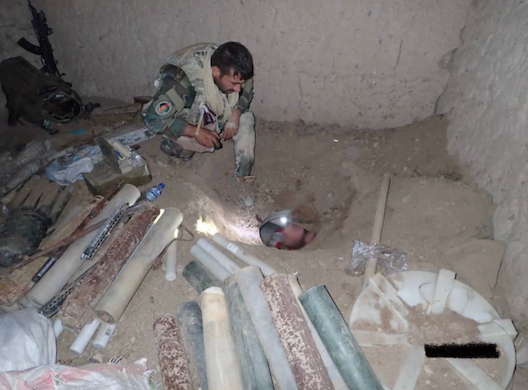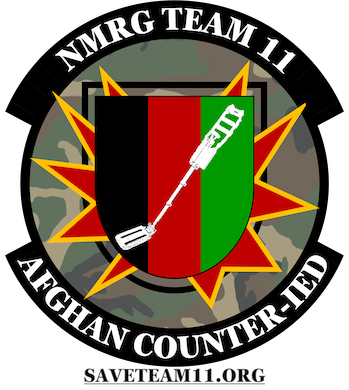Digital Dunkirk: Green Berets Network To Save Afghans Who Saved Them
The Special Operations Forces community battles to help members of the National Mine Reduction Group secure Special Immigrant Visas and safe passage to the United States.

It’s been nearly a year since the American withdrawal from Afghanistan, but for some in the Special Operations Forces community last August was just the beginning of a new battle: to help the roughly 300 Afghan counter-IED specialists, members of the National Mine Reduction Group, secure Special Immigrant Visas and safe passage to the United States.
This is not a battle they were expecting to fight.
“I can’t give you an accurate estimate of how many Green Berets are alive today because of NMRG,” Green Beret Thomas Kasza, who managed a NMRG team in Afghanistan in 2019 and now serves in the National Guard, tells the Sun. “I can personally say my legs are still intact because of these guys.”
Last November, Mr. Kasza founded a nonprofit, Save Team 11 — named after the group he worked with in Afghanistan — to draw attention to the NMRG veterans stuck in Afghanistan and facing Taliban retribution, and to push the U.S. state department to prioritize these men and their families for immigration to America.
In their final weeks in Afghanistan, America and its allies evacuated more than 120,000 people on a combination of military, commercial, and charter flights. Amid the chaos at Hamid Karzai International Airport — with crowds packing the perimeter, desperate Afghans clinging to C-17s as they took off, and a suicide bomber blowing himself up at Abbey Gate — much of the focus was on the number of translators who were left behind.
The plight of members of the National Mine Reduction Group and their families got lost in the fray. Small in number and having worked primarily with Special Operations Forces like the Green Berets, the NMRG are unknown to most Americans and their contribution to the U.S. war effort has gotten little press.
Mr. Kasza describes the NMRG this way: “Exchange the well-known narrative of ‘They provided Dari-English translations’ with ‘They swept for IEDs at the forefront of Special Forces night raids,’ and you begin to have a sense of the kinds of risks undertaken by the Afghan men of the National Mine Reduction Group.”

A large proportion of NMRG are Hazaras, a Shiite ethnic minority whom the Taliban have historically persecuted. While Mr. Kasza says he had his “head on a swivel” around Afghan army units, he never doubted the loyalties of the NMRG, whom the Army rigorously vetted and trained. They lived and worked alongside American Special Operations Forces and, he says, were “firmly, unequivocally on our side.”
The Sun spoke with several Green Berets who corroborate this and tell stories of the NMRG saving their lives. They tell of NMRG dismantling IEDs by hand on night raids, of leading the way into enemy fire, and of taking other enormous risks. They also tell stories of NMRG getting blown up, paralyzed, and injured — yet coming back to serve. “If that was some American doing that, they’d be getting some award or some medal,” a Green Beret tells the Sun.
The Sun also spoke with one NMRG translator and a NMRG team leader who now lives in Nebraska. All except for Mr. Kasza asked that their names be withheld because they still actively deploy or are worried about Taliban retribution on their families in Afghanistan.
The NMRG are being actively “hunted down” by the Taliban, according to these sources. The NMRG team leader says his brother was detained by the Taliban and that other men he worked with have been tortured.

“They’re in significant risk,” an active duty Green Beret tells the Sun. “It feels like they were just left there and there is not a whole lot of attention being given to them.”
Mr. Kasza’s mission began when he was watching the chaotic withdrawal unfold at Hamid Karzai International Airport from his home at Tacoma, Washington. He started receiving WhatsApp messages from NMRG and translators he had worked with in 2019, asking for his help.
Mr. Kasza and his fellow Green Berets reactivated the Signal and WhatsApp group chats from their tours in Afghanistan and began making lists of the NMRG they had worked with and reached out to help. He calls his network of Green Berets “amateur humanitarians,” and their mission a “digital Dunkirk.”
They had some initial successes. Mr. Karsza steered Mahdi Hussaini, a translator who worked alongside NMRG Team 11, to the airport by finding a National Geographic support team for Mr. Hussaini to link up with. Getting the WhatsApp image of Mr. Hussaini aboard a C-17 “was one of those things you’ll never forget,” he says.
Another Green Beret advised a group of NMRG to link up with the Afghan girls robotics team. They all made it out.
There were, though, many more disappointments. One Green Beret describes trying to guide an NMRG he’d worked with, who got paralyzed during a mission, to the airport gates. Amidst the chaos and in a wheelchair, he recounts, “it was impossible to get him in front of any of the crowds.”
“Especially after the suicide bomb, it was some hard, uncomfortable conversations,” a Green Beret tells the Sun, referring to the August 26 ISIS suicide bombing outside Abbey Gate that killed more than 160 civilians and 13 American service members.
Flights from Afghanistan stopped. Mr. Kasza joined Zoom meetings for nonprofits that were formed in the wake of the U.S. withdrawal and that were trying to get out Afghans who worked with the Americans. The problem, though, was that most in these groups had never heard of the NMRG, and they weren’t given priority.
“Not all SIVs are created equal,” a Green Beret tells the Sun of the Special Immigrant Visa program. The NMRG risked their lives in combat missions with the Americans, but they aren’t given priority over an Afghan with an SIV who did laundry at a base or who was a translator with a desk job.

of the NMRG. Via Thomas Kasza
Mr. Kasza founded Save Team 11 to redress this. Run by active duty and National Guard Green Berets, the organization is ramping up its efforts now as the one-year anniversary of withdrawal approaches and progress in getting these guys out is slow.
Several Green Berets expressed frustration at the pace with which Ukrainians are getting SIVs, while the NMRG who served — some for more than a decade — are languishing in safe houses in Afghanistan and Pakistan waiting for interviews and flights.
One Green Beret told the Sun he has spent $100,000 from a private donation and more than $30,000 of his own money on safe houses for NMRG, food, and passports that cost $1,200 under the “bribery system that exists now.” He says dealing with the state department for updates on SIV and flight statuses is worse than dealing with Amazon for a return. The phone wait times are often hours long.
Independent fishing boats helped save British and French troops in Dunkirk, but Mr. Kasza is hoping to get official channels involved in his mission. He is trying to get the attention of state department officials and politicians with the power to help change policy and prioritize the NMRG for immigration to America.
The Sun reached out for comment to the state department and to Representative Michael Waltz, a Republican from Florida who was the first Green Beret elected to Congress, but has yet to hear back.
For now, the “digital Dunkirk” soldiers on.
“These people fought alongside us, they bled with us, they died alongside us. There’s one guy that’s still in Kabul that I will never stop helping that pulled me off a pressure plate that was double rigged to mortar rounds. If one had gone off, it would have killed me,” a Green Beret says. “To leave them out there is just unacceptable.”

